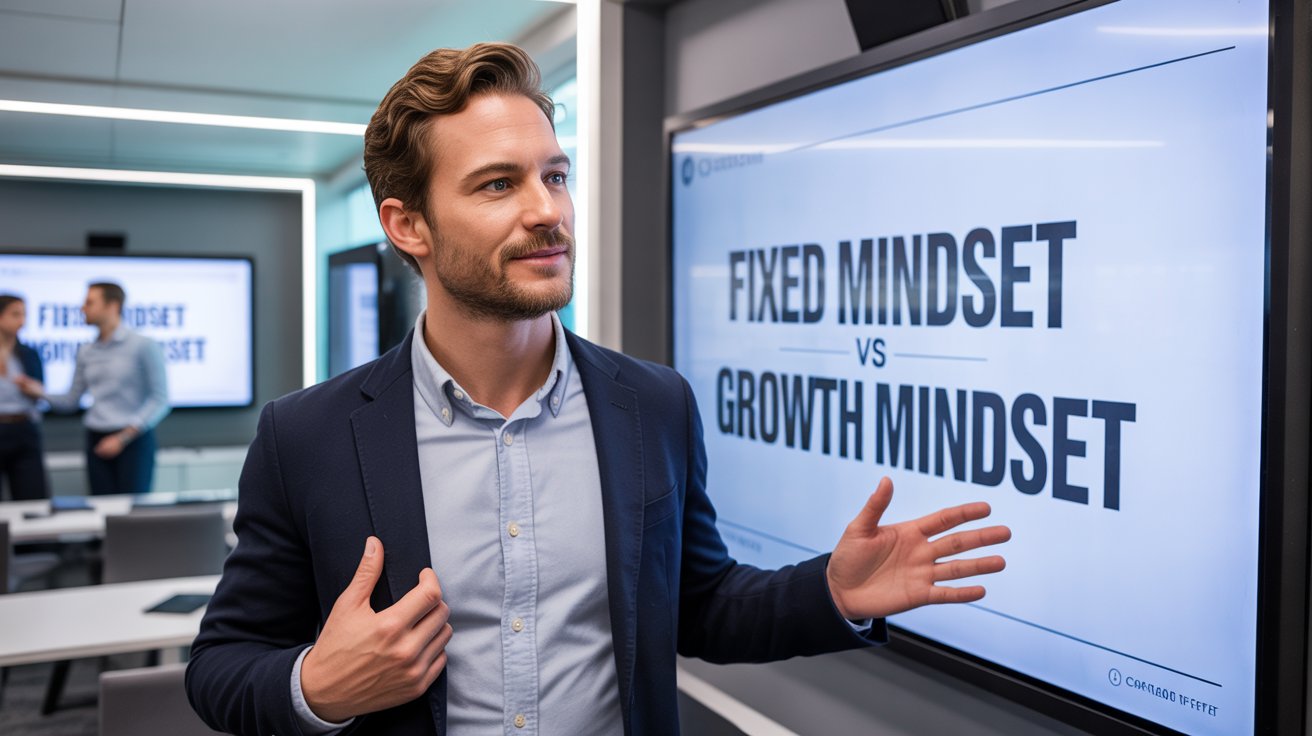A growth mindset is an underlying mechanism of growth across every discipline. Be it any industry, including tech, financial, healthcare, or design. It inspires employees to strive for continuous learning, experimentation, and improvement. In a work setting, this mentality supports innovation and collaboration. Employees believe that they are capable of developing their own skills. They tackle challenges with the curiosity to know, rather than the angst of what they might lose. For example, the product development team might be under pressure to deliver a product. Rather than being frustrated by the challenge, they consider each challenge as yet another exploration.

Jump ahead to
Power of Growth Mindset in Organizations
Thinking about it, what would it mean for the organization if every employee viewed challenges as opportunities to grow? If employees react to setbacks as opportunities for forward progress, excited about learning and improving their skills? This scenario is not an example of blind optimism. Rather, the fruits of successful and effective Growth Mindset Training. So, how can organizations create a program that redefines training as instilling the principles of a growth mindset across the board?
Research reveals that organizations that practice and promote a growth mindset see dramatic changes in employee performance and overall work culture. A Stanford University study indicates that employees who perceive their abilities can be cultivated through hard work outperform their colleagues and demonstrate better resilience.
This blog discusses the critical components of a corporate Growth Mindset Training Program that will make a difference and produce an irreversible transformation.
Fixed Mindset vs Growth Mindset
Think of two employees, both faced with a challenging situation. One employee thinks immediately, “I’m just not good at this”, and gives up. The other one thinks, “This is difficult, but I can get better if I try”, and begins engaging with an inquisitive mind. That small difference? The impact of mindset.
A fixed mindset assumes that talent and intelligence are set in stone. Mistakes come across as failure, while challenges create fear with no excitement. People with this view avoid risk, run from feedback, and stick to comfortable methods. This ultimately hinders their growth as individuals and teams.
A growth mindset, on the other hand, looks at every challenge as a lesson. This mindset says, “I haven’t mastered this yet,” instead of, “I can’t do this.” People with growth mindsets engage with the struggle, learn from feedback, and celebrate forward momentum. Additionally, it creates an unknown level of creativity and resilience.
So why does that matter to your organization? When employees have a growth mindset, they ignite change and innovation in their teams, deepen collaboration, and shift failures or setbacks into meaningful learning experiences. It’s the best-kept secret to developing in a constantly changing world, where the ability to develop is one of the best competitive advantages we have.
Growth Mindset Vs Fixed Mindset- A Comparison
| Dimension | Growth Mindset | Fixed Mindset |
| Core Belief System | Abilities can be developed through learning, practice, and perseverance | Talent and intelligence are innate and unchangeable. |
| Approach to Challenges | View challenges as opportunities to explore, learn, and stretch capabilities. | Sees challenges as threats that highlight limitations and prefers to avoid them. |
| Attitude Toward Effort | Believes effort is essential for mastery and continuous improvement. | Believes effort signals a lack of natural ability and should be minimized. |
| Reaction to Setbacks | Treats setbacks as valuable lessons that guide future improvement. | Considers setbacks as failures and reasons to quit or withdraw. |
| Response to Feedback | Welcomes constructive feedback as a tool to grow and refine skills. | Avoids feedback, feeling it is a criticism or a threat to self-image. |
| Openness to Learning | Actively seeks new knowledge, skills, and learning experiences. | Prefers familiar methods and avoids situations requiring new learning. |
| Collaboration Style | Shares ideas openly, seeks help, and encourages collective learning. | Works in isolation, avoids seeking help to protect perceived competence. |
| Risk-Taking Behavior | Confidently experiments and embraces uncertainty to innovate. | Avoids risks to prevent mistakes and protects reputation. |
Understanding the Growth Mindset
Before embarking on any training program, understanding the growth mindset is very important. This growth mindset was developed by psychologist Carol Dweck. It signifies that individuals who have the conviction that their skills and talents can be improved will accept challenges. Further, they will look at the effort as a crucial step toward mastery, and not as a sign of inferiority. Characteristics of a growth mindset –
Taking challenges
Individuals with a growth mindset are not afraid to take risks and challenges. They usually regard failures as ways to gather more knowledge and experience. For instance, an employee might want to work on a project that is not within his capabilities, but will think of the project as a source of learning, instead of a setback.
No Quitting
Keeping our heads up is the very basis of the growth mindset. Employees start viewing the loss as a source of new skills rather than a sole bad end. For example, if a marketing team had an advertisement that was not well received by the clients, they would review the data collectively by discussing what did not go well and what they could improve upon in the future.
Value Feedback
Individuals with a growth mindset search out evaluative feedback. They consider this tool, help them improve, not an insult. In a corporate context, an individual is seeking interaction in a performance evaluation, where they will ask for advice and support development on their skills, with the hope of enhancing their skills.
Recognition of Effort
A Growth mindset focuses on effort and not on innate qualities and abilities. Employees are inspired to track progress and acknowledge small wins. For example, a sales team may track their number of client interactions. Thus, learning to communicate effectively is one way to celebrate progress before seeing substantial increases in sales volume.
Lifelong Learning
Individuals who have a growth mindset are committed to learning. They will seek any new learning opportunity they can identify. Organizations can foster this belief by providing opportunities for professional development through workshops and mentorship programs.
Benefits of Growth Mindset Training
There are numerous advantages of Growth Mindset Training:
Improved Problem-Solving Skills
Employees realize they can approach problems with curiosity. They become more open to experimentation and risk-taking when they understand that making mistakes is important to the process of learning. This incorporates a meaningful improvement of individual capability and inculcates a systemic culture of problem-solving together.
Enhanced Teamwork
A shared mindset opens the door to communication. When employees believe that everyone can grow, they are inherently likely to share ideas and ask for help in new ways. This environment strengthens the trust/respect dynamic, which benefits the overall team.
Strengthened Resilience
Employees become flexible and adaptable. They learn to see setbacks as unfamiliar paths to learning something new. Further, it helps them re-establish their equilibrium quickly. This establishes a culture of celebration of persistence.
Increased Engagement and Motivation
A commitment to ensuring members of the workforce develop personally nurtures motivation. Employees are more likely to be engaged in the sector when they feel supported in their personal development. Higher engagement leads to employee satisfaction and lower employee retention.
Steps to Establish a Growth Mindset Training Program
There are a few steps to establishing a Growth Mindset Training Program. As an organization, you will want to do the following:
Stage 1: Evaluate Organizational Needs
Start with an inquiry into the existing culture. Identify areas where a fixed mindset is a problem (e.g., an unwillingness to take risks). Surveys and focus groups are valuable ways to understand employee thinking and experiences. To navigate these challenges, this assessment will allow for training content to be customized.
Stage 2: Establish Objectives
Establish clear objectives for the training. A clear idea of what desired outcomes you have in mind is important. These objectives could be aimed at building employee engagement, building innovation, etc. With clear objectives that tie to your company’s purpose, you will have greater support and excitement for your training initiative.
Stage 3: Construct a Complete Curriculum
Growth Mindset Training requires a thoughtfully designed curriculum to be effective. It is essential to ensure that the curriculum utilizes all aspects, like workshops, practical case studies, and group activities. Certainly, discussion-based workshops and case studies can encourage employees to engage and share their views on the mindset. It can create an impact on preconceived notions and fit into perspectives. Additionally, group activities lead employees to engage collaboratively in discussing their interpretation of the mindset activities.
Step 4: Encourage Ongoing Learning
Understand that increasing employees’ growth mindsets will not end when individuals complete training. Ongoing learning can happen through additional workshops, coaching, and resource access. Providing a space and structure for employees to share their learning experience encourages continuous learning.
Step 5: Track Outcomes
Establish metrics to measure learning and application after training. Use surveys to assess changes in growth mindset beliefs and employee positive satisfaction. Capture performance-related data, for instance, productivity data, but with awareness not to confuse numbers with performance evaluation, and assess prospects of learning. Measuring results and routinely checking in with employees will relate to learning and concrete expectations of practice, if it was learned in practice instances.
Creating a Supportive Culture
Creating a supportive culture around the growth mindset program is critical. Categories include creating an environment where employees feel free to take risks and feel free to share their thinking. Encouraging dialogue about one of your learning experiences provides employees with more than engagement when it fosters trust and builds collaboration with staff.
Leadership Support
Leadership plays a powerful role in embedding a growth mindset mission in an environment. It must model growth mindset behaviors that share some level of discomfort, mistakes, and possibilities of learning, without divulging too much emotion. When management illustrates a growth mindset, employees follow suit. Moreover, as leadership demonstrates their willingness to share and learn, even within their discomfort, it is evidence of a commitment to growth as a priority.
Recognition & Rewards
Have a recognition program, like peer-to-peer or professional recognition. It recognizes efforts made toward adopting an organization’s growth mindset goals. Acknowledge employees who take risks, learn from mistakes, and contribute to a collaborative environment. Celebrating small wins creates a powerful ripple effect. Moreover, encourage a culture of appreciation and support.
Open Communication Channels
Encourage open dialogue about challenges and failures. Create safe spaces where employees can share experiences without fear of retribution. This openness cultivates trust and allows individuals to learn from each other. When people feel safe expressing vulnerabilities, it fosters a deeper sense of community.
Conclusion
To launch a successful Growth Mindset Training, organizations need commitment, planning, and execution. Organizations that establish a culture of challenge and growth and not failure,e can unlock the potential of their future workforce. The benefits of a growth mindset are not limited to employees. They will permeate the teams and the rest of the organization.
As an organization embarking on an innovative and collaborative environment, the journey of growth may seemingly be pointless, but the rewards are worth it. Moreover, a growth mindset prepares them for more challenges and helps lead a sustainable way for employee success.
FAQs on Growth Mindset
1. What is Growth Mindset Training?
It empowers employees to believe they can improve through effort and learning. Such training nurtures resilience, teamwork, and innovative thinking within the workplace.
2. Why is a growth mindset important for organizations?
It transforms challenges into learning opportunities. Employees feel motivated to adapt, experiment, and find creative solutions that enhance performance.
3. How does a growth mindset differ from a fixed mindset?
A fixed mindset limits potential and avoids challenges. In contrast, a growth mindset accepts mistakes as part of the learning process and thrives on continuous progress.
4. What activities are part of Growth Mindset Training?
Activities in Growth Mindset Training can include workshops, real-life case studies, peer collaboration practice, and a reflection on processes that promote curiosity and feedback.
5. How can leaders promote a growth mindset?
Leaders engaged in learning processes inspire others when they are open to feedback, and share their stories of learning. When leaders celebrate progress, employees feel encouraged to learn.
6. How long does it take for any results to be seen?
Positive change is often achieved in a short-time frame, often to witness behavioral shifts. The team shows greater confidence, creativity, and problem-solving ability.
7. How can organizations assess effectiveness?
Surveys, performance trends, and feedback sessions reveal thinking patterns, whether patterns of collaboration shift. Continued cycles of data review will sustain the new level of performance.
8. How does growth mindset training enhance employee well-being?
It helps employees handle stress more effectively and view challenges with optimism. A supportive learning culture improves confidence, morale, and overall job satisfaction.
9. What helps maintain long-term results?
Regular follow-up sessions, mentoring, and performance reflections will sustain the principles of growth embedded in normal work practices.
10. Which industries benefit the most from Growth Mindset Training?
Every industry gains value. Especially fast-changing fields like technology, healthcare, and finance, where adaptability drives success.



